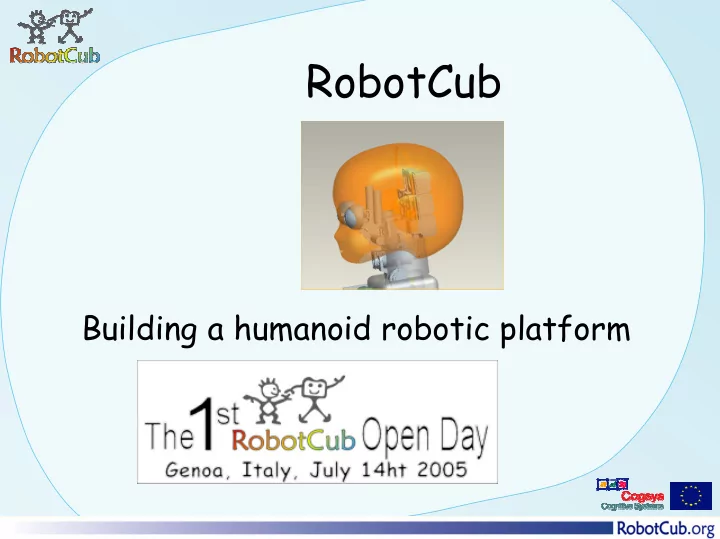

RobotCub Building a humanoid robotic platform
Outline • Our motivations – Why do we do what we do? • Building what – A humanoid robot • Our goals – Understanding cognition, building cognition
Two keywords “Perception, cognition and motivation develop at the interface between neural processes and actions. They are a function of both these things and arise from the dynamic interaction between the brain, the body and the outside world” Von Hofsten, TICS 2004
• Development: to replicate something requires to know how to build it – Corollary: “building” is not entirely like “understanding” • Action: interaction in the real world requires a body – Corollary: the shape of the body determines the affordances that can be exploited
What is changing?
• The controller is changing, coordination is changing • Konczak et al. for instance showed that it is not a problem of peak “torque” generation but one of control
Action is important
The perception of actions happens through the mediation of the action system i.e. perception is not the private affair of the sensory systems
LIRA-Lab, 1991 or so Active perception
Also, objects come to existence because they are manipulated Fixate target Track visual (…including Detect moment Separate arm, Segment object motion… cast shadows) of impact object motion Which edge should be Maybe some cruel considered? grad-student glued the cube to the table Color of cube and table are poorly separated Cube has misleading surface pattern
Exploring an affordance: rolling A toy car: it rolls in the A bottle: it rolls orthogonal to the direction of its principal axis direction of its principal axis A toy cube: it doesn’t roll, A ball: it rolls, it doesn’t have a principal axis it doesn’t have a principal axis
An old video…
The MIRROR project 2 cameras To disk Frame Images grabbers Cyber-glove Other RS232 sensors To disk 40 msec Tracker RS232 Tactile sensors
Bayesian classifier 168 sequences per subject 10 subjects { G i }: set of gestures 6 complete sets F : observed features { O k }: set of objects z y ~ 76 cm a x p(G i |O k ) : priors (affordances) p( F |G i ,O k ) : likelihood to observe F ( ) ( ) ( ) ( ) = | , | , | / | p G F O p F G O p G O p F O i k i k i k k ( ) ˆ = arg max | , G G F O -45° (b) +45° (b) MAP i k +90° (a) +180° (a) b G i 0° (b) +135° (a)
Two types of experiments F v , O k G i Vision Classifier F v , O k F m , O k G i Vision VMM Classifier Learned by backpropagation ANN
Has motor information anything to do with recognition? Object affordances (priors) Visual space Motor space Classification (recognition) Grasping actions
Some results… Exp. I Exp. II Exp. III Exp. IV (visual) (visual) (visual) (motor) Training # Sequences 16 24 64 24 # of view points 1 1 4 1 Classification 100% 100% 97% 98% rate # Features 5 5 5 15 # Modes 5-7 5-7 5-7 1-2 Test # Sequences 8 96 32 96 # of view points 1 4 4 4 Classification 100% 30% 80% 97% rate
“In all communication, sender and receiver must be bound by a common understanding about what counts; what counts for the sender must count for the receiver, else communication does not occur. Moreover the processes of production and perception must somehow be linked; their representation must, at some point, be the same.” [Alvin Liberman, 1993]
The ultimate constituents of speech are articulatory gestures (one and the same thing, one concept to rule them all)
Mirror neurons? Vision Acoustic Manipulation Speech Motor Motor Watching others Listening to others
Manipulation, i.e. taking actions → speech
The iCub • Requirements – Hands to manipulate – Arms with a large workspace – Head with fast camera movements – Waist and legs for crawling • Able to crawl & reach to fetch objects and sit to manipulate them • Child-like size
Child-like, how much? 243mm 369mm Approx 934mm 439mm Avg. 14Kg - 30.8 lb
Well… • It is going to be heavier: ~23Kg • 53 degrees of freedom – 9 x2 hands – 7 x2 arms – 6 head – 6 x2 legs – 3 torso • Embedded electronics
Sensors • Cameras • Microphones • Gyroscopes, linear accelerometers • Tactile sensors • Proprioception • Torque sensors • Temperature sensors
Levels Sensors Cluster Relay station DSP PC1 Gbit Ethernet DSP HUB DSP A c DSP t u DSP a PCN t o r s Implementation of the cognitive iCub API Low-level control architecture Embedded
…and, yes, it is open! • GPL for all the software, controller, tools, everything that runs on the robot • FDL for the drawings, electronics, documentations, etc. • Open to new partners and collaborations worldwide
Meet the iCub See you in March 2007!
Recommend
More recommend